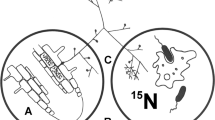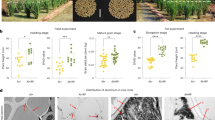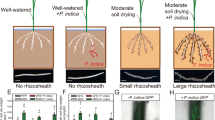Abstract
Anthropogenic nitrogen inputs lead to a high ammonium (NH4+)/nitrate (NO3−) ratio in the soil, which restricts hyphal spreading of soil fungi. Access of symbiotic fungi to roots is a prerequisite for plant-fungal interactions. Hyphosphere bacteria protect fungi from environmental stress, yet the impact of hyphosphere bacteria on adaptation of host fungi to NH4+-enriched conditions remains unclear. By developing soil microcosm assays, we report that a plant-symbiotic fungus, Phomopsis liquidambaris, harbors specific hyphosphere bacteria that facilitate hyphal spreading and assist in the root colonization in NH4+-enriched soil. Genetic manipulation, 16S rRNA gene analysis and coinoculation assays revealed that the genus Enterobacter was enriched in the hyphosphere of NH4+-sensitive wild-type compared to NH4+-preferring nitrite reductase‐deficient strain. The representative Enterobacter sp. SZ2-promoted hyphal spreading is only evident in nonsterilized soil. We further identified an increased abundance and diversity of ammonia-oxidizing archaea (AOA) and a synchronously decreased NH4+:NO3− ratio following SZ2 inoculation. Microbial supplementation and inhibitor assays showed that AOA-mediated reduction in NH4+:NO3− ratio is responsible for SZ2-enhanced fungal adaptation to NH4+-enriched conditions. The Ph. liquidambaris-Enterobacter-AOA triple interaction promoted rice growth in NH4+-enriched soil. Our study reveals the essential role of hyphosphere microorganism-based hyphal spreading in plant-fungal symbiosis establishment within nitrogen-affected agroecosystems.
This is a preview of subscription content, access via your institution
Access options
Subscribe to this journal
We are sorry, but there is no personal subscription option available for your country.
Buy this article
- Purchase on Springer Link
- Instant access to full article PDF
Prices may be subject to local taxes which are calculated during checkout








Similar content being viewed by others
Data availability
Supplementary methods, figures, tables and results are provided in the file Supplementary Information. The 16S rRNA and amoAF/amoAR gene sequencing data are available in the NCBI SRA under BioProject PRJNA835591 and PRJNA837065, respectively.
References
Guether M, Balestrini R, Hannah M, He J, Udvardi MK, Bonfante P. Genome-wide reprogramming of regulatory networks, transport, cell wall and membrane biogenesis during arbuscular mycorrhizal symbiosis in Lotus japonicus. New Phytol. 2009;182:200–12.
Peng L, Shan XL, Yang YZ, Wang YC, Druzhinina IS, Pan XY, et al. Facultative symbiosis with a saprotrophic soil fungus promotes potassium uptake in American sweetgum trees. Plant Cell Environ. 2021;44:2793–809.
Hiruma K, Gerlach N, Sacristán S, Nakano RT, Hacquard S, Kracher B, et al. Root endophyte Colletotrichum tofieldiae confers plant fitness benefits that are phosphate status dependent. Cell. 2016;165:464–74.
Sui XL, Zhang T, Tian YQ, Xue RJ, Li AR. A neglected alliance in battles against parasitic plants: arbuscular mycorrhizal and rhizobial symbioses alleviate damage to a legume host by root hemiparaitic Pedicularis species. New Phytol. 2019;221:470–81.
Harinikumar KM, Bagyaraj DJ. Spread of vesicular arbuscular mycorrhizal fungal hyphae in soil. Microbiol Res. 1995;150:77–80.
Schütz L, Saharan K, Mäder P, Boller T, Mathimaran N. Rate of hyphal spread of arbuscular mycorrhizal fungi from pigeon pea to finger millet and their contribution to plant growth and nutrient uptake in experimental microcosms. Appl Soil Ecol. 2022;169:104156.
Büttner H, Niehs SP, Vandelannoote K, Cseresnyés Z, Dose B, Richter I, et al. Bacterial endosymbionts protect beneficial soil fungus from nematode attack. Proc Natl Acad Sci USA. 2021;118:e2110669118.
Dahlstrom KM, Newman DK. Soil bacteria protect fungi from phenazines by acting as toxin sponges. Curr Biol. 2022;32:275–88.
Rozmoš M, Bukovská P, Hršelová H, Kotianová M, Dudáš M, Gančarčíková K, et al. Organic nitrogen utilisation by an arbuscular mycorrhizal fungus is mediated by specific soil bacteria and a protist. ISME J. 2022;16:676–85.
Zhang L, Zhou J, George TS, Limpens E, Feng G. Arbuscular mycorrhizal fungi conducting the hyphosphere bacterial orchestra. Trends Plant Sci. 2021;27:402–11.
Faghihinia M, Jansa J, Halverson LJ, Staddon PL. Hyphosphere microbiome of arbuscular mycorrhizal fungi: a realm of unknowns. Biol Fert Soils. 2023;59:17–34.
Nguyen NH. Fungal hyphosphere microbiomes are distinct from surrounding substrates and show consistent association patterns. Microbiol Spectr. 2023;11:e0470822.
Ballhausen MB, Boer WD. The sapro-rhizosphere: carbon flow from saprotrophic fungi into fungus-feeding bacteria. Soil Biol Biochem. 2016;102:14–7.
Kuyper TW, Jansa J Arbuscular mycorrhiza: advances and retreats in our understanding of the ecological functioning of the mother of all root symbioses. Plant Soil. 2023. https://doi.org/10.1007/s11104-023-06045-z
Emmett BD, Lévesque-Tremblay V, Harrison MJ. Conserved and reproducible bacterial communities associate with extraradical hyphae of arbuscular mycorrhizal fungi. ISME J. 2021;15:2276–88.
Luthfiana N, Inamura N, Tantriani, Sato T, Saito K, Oikawa A, et al. Metabolite profiling of the hyphal exudates of Rhizophagus clarus and Rhizophagus irregularis under phosphorus deficiency. Mycorrhiza. 2021;31:403–12.
Deveau A, Bonito G, Uehling J, Paoletti M, Becker M, Bindschedler S, et al. Bacterial-fungal interactions: ecology, mechanisms and challenges. FEMS Microbiol Rev. 2018;42:335–52.
Zhang W, Li XG, Sun K, Tang MJ, Xu FJ, Zhang M, et al. Mycelial network-mediated rhizobial dispersal enhances legume nodulation. ISME J. 2020;14:1–15.
Jiang FY, Zhang L, Zhou JC, George TS, Feng G. Arbuscular mycorrhizal fungi enhance mineralisation of organic phosphorus by carrying bacteria along their extraradical hyphae. New Phytol. 2021;230:304–15.
Otto S, Bruni EP, Harms H, Wick LY. Catch me if you can: dispersal and foraging of Bdellovibrio bacteriovorus 109J along mycelia. ISME J. 2017;11:386–93.
Junier P, Cailleau G, Palmieri I, Vallotton C, Trautschold OC, Junier T, et al. Democratization of fungal highway columns as a tool to investigate bacteria associated with soil fungi. FEMS Microbiol Ecol. 2021;97:fiab003.
Zhang L, Xu MG, Liu Y, Zhang FS, Hodge A, Feng G. Carbon and phosphorus exchange may enable cooperation between an arbuscular mycorrhizal fungus and a phosphate-solubilizing bacterium. New Phytol. 2016;210:1022–32.
Salvioli A, Ghignone S, Novero M, Navazio L, Venice F, Bagnaresi P, et al. Symbiosis with an endobacterium increases the fitness of a mycorrhizal fungus, raising its bioenergetic potential. ISME J. 2016;10:130–44.
Mondo SJ, Lastovetsky OA, Gaspar ML, Schwardt NH, Barber CC, Riley R, et al. Bacterial endosymbionts influence host sexuality and reveal reproductive genes of early divergent fungi. Nat Commun. 2017;8:1843.
Torres-Cortés G, Ghignone S, Bonfante P, Schüßler A. Mosaic genome of endobacteria in arbuscular mycorrhizal fungi: transkingdom gene transfer in an ancient mycoplasma-fungus association. Proc Natl Acad Sci USA. 2015;112:7785–90.
Desirò A, Hao Z, Liber JA, Benucci GMN, Lowry D, Roberson R, et al. Mycoplasma-related endobacteria within Mortierellomycotina fungi: diversity, distribution and functional insights into their lifestyle. ISME J. 2018;12:1743–57.
Pawlowska TE, Gaspar ML, Lastovetsky OA, Mondo SJ, Real-Ramirez I, Shakya E, et al. Biology of fungi and their bacterial endosymbionts. Annu Rev Phytopathol. 2018;56:289–309.
Guo S, Tao CY, Jousset A, Xiong W, Wang Z, Shen ZZ, et al. Trophic interactions between predatory protists and pathogen-suppressive bacteria impact plant health. ISME J. 2022;16:1932–43.
Tilman D. Global environmental impacts of agricultural expansion: the need for sustainable and efficient practices. Proc Natl Acad Sci USA. 1999;96:5995–6000.
DePasquale DA, Montville TJ. Mechanism by which ammonium bicarbonate and ammonium sulfate inhibit mycotoxigenic fungi. Appl Environ Microbiol. 1990;56:3711–7.
Pattinson GS, Sutton BG, Mcgee PA. Leachate from a waste disposal centre reduces the initiation of arbuscular mycorrhiza, and spread of hyphae in soil. Plant Soil. 2000;227:35–45.
Porras-Alfaro A, Bayman P. Hidden fungi, emergent properties: endophytes and microbiomes. Annu Rev Phytopathol. 2011;49:291–315.
Yang B, Wang XM, Ma HY, Jia Y, Li X, Dai CC. Effects of the fungal endophyte Phomopsis liquidambari on nitrogen uptake and metabolism in rice. Plant Growth Regul. 2014;73:165–79.
Sun K, Zhang W, Yuan J, Song SL, Wu H, Tang MJ, et al. Nitrogen fertilizer-regulated plant-fungi interaction is related to root invertase-induced hexose generation. FEMS Microbiol Ecol. 2020;96:fiaa139.
Li GJ, Zhang L, Wu JL, Yue XY, Wang M, Sun L, et al. OsEIL1 protects rice growth under NH4+ nutrition by regulating OsVTC1-3-dependent N-glycosylation and root NH4+ efflux. Plant Cell Environ. 2022;45:1537–53.
Sun K, Lu F, Huang PW, Tang MJ, Xu FJ, Zhang W, et al. Root endophyte differentially regulates plant response to NO3- and NH4+ nutrition by modulating N fluxes at the plant-fungal interface. Plant Cell Environ. 2022;45:1813–28.
Yang B, Wang XM, Ma HY, Yang T, Jia Y, Zhou J, et al. Fungal endophyte Phomopsis liquidambari affects nitrogen transformation processes and related microorganisms in the rice rhizosphere. Front Microbiol. 2015;6:982.
Liu DM, Zhang SR, Fei C, Ding XD. Impacts of straw returning and N application on NH4+-N loss, microbially reducible Fe (III) and bacterial community composition in saline-alkaline paddy soils. Appl Soil Ecol. 2021;168:104115.
Zhang JY, Liu YX, Zhang N, Hu B, Jin T, Xu HR, et al. NRT1.1B is associated with root microbiota composition and nitrogen use in field-grown rice. Nat Biotechnol. 2019;37:676–84.
Sun K, Cao W, Hu LY, Fu WQ, Gong JH, Kang N, et al. Symbiotic fungal endophyte Phomopsis liquidambari-rice system promotes nitrogen transformation by influencing below-ground straw decomposition in paddy soil. J Appl Microbiol. 2019;126:191–203.
Jiang YJ, Liu MQ, Zhang JB, Chen Y, Chen XY, Chen LJ, et al. Nematode grazing promotes bacterial community dynamics in soil at the aggregate level. ISME J. 2017;11:2705–17.
Chen Y, Xie XG, Ren CG, Dai CC. Degradation of N-heterocyclic indole by a novel endophytic fungus Phomopsis liquidambari. Bioresour Technol. 2013;129:568–74.
Rotthauwe JH, Witzel KP, Liesack W. The ammonia monooxygenase structural gene amoA as a functional marker: molecular fine-scale analysis of natural ammonia-oxidizing populations. Appl Environ Microbiol. 1997;63:4704–12.
Francis CA, Roberts KJ, Beman JM, Santoro AE, Oakley BB. Ubiquity and diversity of ammonia-oxidizing archaea in water columns and sediments of the ocean. Proc Natl Acad Sci USA. 2005;102:14683–8.
Gaby JC, Buckley DH. A comprehensive evaluation of PCR primers to amplify the nifH gene of nitrogenase. PLoS One. 2012;7:e42149.
Sun XL, Xu ZH, Xie JY, Hesselberg-Thomsen V, Tan TM, Zheng DY, et al. Bacillus velezensis stimulates resident rhizosphere Pseudomonas stutzeri for plant health through metabolic interactions. ISME J. 2022;16:774–87.
Liu F, Jin PP, Sun ZL, Du LH, Wang DY, Zhao T, et al. Carvacrol oil inhibits biofilm formation and exopolysaccharide production of Enterobacter cloacae. Food Control. 2021;119:107473.
Xu FY, Liao HP, Zhang YJ, Yao MJ, Liu JP, Sun LY, et al. Coordination of root auxin with the fungus Piriformospora indica and bacterium Bacillus cereus enhances rice rhizosheath formation under soil drying. ISME J. 2022;16:801–11.
Tatari K, Gülay A, Thamdrup B, Albrechtsen HJ, Smets BF. Challenges in using allylthiourea and chlorate as specific nitrification inhibitors. Chemosphere. 2017;182:301–5.
Fisk LM, Maccarone LD, Barton L, Murphy DV. Nitrapyrin decreased nitrification of nitrogen released from soil organic matter but not amoA gene abundance at high soil temperature. Soil Biol Biochem. 2015;88:214–23.
Wan WJ, He DL, Xue ZJ. Removal of nitrogen and phosphorus by heterotrophic nitrification-aerobic denitrification of a denitrifying phosphorus-accumulating bacterium Enterobacter cloacae HW-15. Ecol Eng. 2017;99:199–208.
Bei QC, Xie ZB, Cadisch G, Rasche F. K-strategic ammonia-oxidizing bacteria capitalize on biological nitrogen fixation in a flooded, unfertilized rice soil. Biol Fert Soils. 2019;55:713–22.
Kronzucker HJ, Glass ADM, Siddiqi MY, Kirk GJD. Comparative kinetic analysis of ammonium and nitrate acquisition by tropical lowland rice: implications for rice cultivation and yield potential. New Phytol. 2000;145:471–76.
Kirk GJD. Plant-mediated processes to acquire nutrients: nitrogen uptake by rice plants. Plant Soil. 2001;232:129–34.
Zhou J, Li X, Huang PW, Dai CC. Endophytism or saprophytism: decoding the lifestyle transition of the generalist fungus Phomopsis liquidambari. Microbiol Res. 2018;20:99–112.
Carrara JE, Walter CA, Hawkins JS, Peterjohn WT, Averill C, Brzostek ER. Interactions among plants, bacteria, and fungi reduce extracellular enzyme activities under long-term N fertilization. Glob Chang Biol. 2018;24:2721–34.
Lilleskov EA, Kuyper TW, Bidartondo MI, Hobbie EA. Atmospheric nitrogen deposition impacts on the structure and function of forest mycorrhizal communities: A review. Environ Pollut. 2019;246:148–62.
Garbaye J. Helper bacteria-a new dimension to the mycorrhizal symbiosis. New Phytol. 1994;128:197–210.
Gahan J, Schmalenberger A. Arbuscular mycorrhizal hyphae in grassland select for a diverse and abundant hyphospheric bacterial community involved in sulfonate desulfurization. Appl Soil Ecol. 2015;89:113–21.
Kim DR, Cho G, Jeon CW, Weller DM, Thomashow LS, Paulitz TC, et al. A mutualistic interaction between Streptomyces bacteria, strawberry plants and pollinating bees. Nat Commun. 2019;10:4802.
Nuccio EE, Hodge A, Pett-Ridge J, Herman DJ, Weber PK, Firestone MK. An arbuscular mycorrhizal fungus significantly modifies the soil bacterial community and nitrogen cycling during litter decomposition. Environ Microbiol. 2013;15:1870–81.
Hausmann B, Knorr KH, Schreck K, Tringe SG, Rio TGD, Loy A, et al. Consortia of low-abundance bacteria drive sulfate reduction-dependent degradation of fermentation products in peat soil microcosms. ISME J. 2016;10:2365–75.
Li ZF, Bai XL, Jiao S, Li YM, Li PR, Yang Y, et al. A simplified synthetic community rescues Astragalus mongholicus from root rot disease by activating plant-induced systemic resistance. Microbiome. 2021;9:217.
Xiong BJ, Stanley CE, Dusny C, Schlosser D, Harms H, Wick LY. pH Distribution along growing fungal hyphae at microscale. J Fungi. 2022;8:599.
Tao CY, Li R, Xiong W, Shen ZZ, Liu SS, Wang BB, et al. Bio-organic fertilizers stimulate indigenous soil Pseudomonas populations to enhance plant disease suppression. Microbiome. 2020;8:137.
Hamilton TL, Koonce E, Howells A, Havig JR, Jewell T, de la Torre JR, et al. Competition for ammonia influences the structure of chemotrophic communities in geothermal springs. Appl Environ Microbiol. 2014;80:653–61.
Uehling J, Gryganskyi A, Hameed K, Tschaplinski T, Misztal PK, Wu S, et al. Comparative genomics of Mortierella elongata and its bacterial endosymbiont Mycoavidus cysteinexigens. Environ Microbiol. 2017;19:2964–83.
Dudáš M, Pjevac P, Kotianová M, Gančarčíková K, Rozmoš M, Hršelová H, et al. Arbuscular mycorrhiza and nitrification: disentangling processes and players by using synthetic nitrification inhibitors. Appl Environ Microbiol. 2022;88:e0136922.
Nuccio EE, Blazewicz SJ, Lafler M, Campbell AN, Kakouridis A, Kimbrel JA, et al. HT-SIP: a semi-automated stable isotope probing pipeline identifies cross-kingdom interactions in the hyphosphere of arbuscular mycorrhizal fungi. Microbiome. 2022;10:199.
Ma B, Wang HZ, Dsouza M, Lou J, He Y, Dai ZM, et al. Geographic patterns of cooccurrence network topological features for soil microbiota at continental scale in eastern China. ISME J. 2016;10:1891–901.
Venkatesh N, Greco C, Drott MT, Koss MJ, Ludwikoski I, Keller NM, et al. Bacterial hitchhikers derive benefits from fungal housing. Curr Biol. 2022;32:1523–33.
Bloom AJ. The increasing importance of distinguishing among plant nitrogen sources. Curr Opin Plant Biol. 2015;25:10–6.
Zhu Q, Wu YB, Chen M, Lu F, Sun K, Tang MJ, et al. Preinoculation with endophytic fungus Phomopsis liquidambaris reduced rice bakanae disease caused by Fusarium proliferatum via enhanced plant resistance. J Appl Microbiol. 2022;133:1566–80.
Zhong Y, Xun WB, Wang XH, Tian SW, Zhang YC, Li DW, et al. Root-secreted bitter triterpene modulates the rhizosphere microbiota to improve plant fitness. Nat Plants. 2022;8:887–96.
Youseif SH, Abd El-Megeed FH, Abdelaal AS, Ageez A, Martínez-Romero E. Plant-microbe-microbe interactions influence the faba bean nodule colonization by diverse endophytic bacteria. FEMS Microbiol Ecol. 2021;97:fiab138.
Acknowledgements
We would like to acknowledge the National Natural Science Foundation of China (No. 32071638), Jiangsu Funding Program for Excellent and Postdoctoral Talent (2022ZB357), China Postdoctoral Science Foundation (2021M701748), and a project funded by the Priority Academic Program Development (PAPD) of the Jiangsu Higher Education Institutions of China.
Author information
Authors and Affiliations
Contributions
KS, WZ, and CCD designed the study and wrote the manuscript. KS, HJJ, YTP, and FL performed experiments. KS, QZ, CYM, and AYZ analyzed the data. JYZ revised the paper. All of authors read and approved the final manuscript.
Corresponding authors
Ethics declarations
Competing interests
The authors declare no competing interests.
Additional information
Publisher’s note Springer Nature remains neutral with regard to jurisdictional claims in published maps and institutional affiliations.
Supplementary information
Rights and permissions
Springer Nature or its licensor (e.g. a society or other partner) holds exclusive rights to this article under a publishing agreement with the author(s) or other rightsholder(s); author self-archiving of the accepted manuscript version of this article is solely governed by the terms of such publishing agreement and applicable law.
About this article
Cite this article
Sun, K., Jiang, HJ., Pan, YT. et al. Hyphosphere microorganisms facilitate hyphal spreading and root colonization of plant symbiotic fungus in ammonium-enriched soil. ISME J 17, 1626–1638 (2023). https://doi.org/10.1038/s41396-023-01476-z
Received:
Revised:
Accepted:
Published:
Issue Date:
DOI: https://doi.org/10.1038/s41396-023-01476-z
This article is cited by
-
Decoding the microbiome for sustainable agriculture
aBIOTECH (2024)



